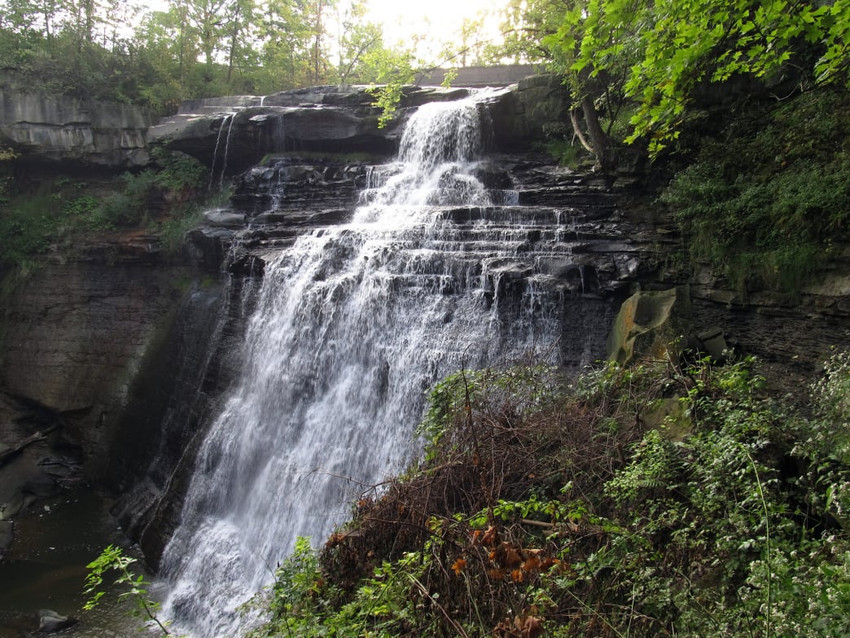Insider's Guide to Cuyahoga Valley National Park
Posted by Toby on Oct 9th 2019
Though it’s located between Cleveland and Akron, Ohio, Cuyahoga Valley National Park feels like a lush escape from urban reality. The park, which was deemed a national recreation area in 1974 and named a national park in 2000, protects roughly 33,000 acres along the Cuyahoga River in northeastern Ohio. More than 125 miles of hiking trails wind throughout the park, passing through low-density forests, wetlands, and fields.
The park’s spectacular waterfalls are surrounded by deep green leaves that turn brilliant shades of gold and orange each fall. It’s a destination for birders, with two sanctuaries for Great Blue Heron, and a serene setting for catching a glimpse of a beaver or a river otter. It’s also a history-lover’s paradise, with a handful of historic structures built in the 1800s that are still in use today.
Classic Adventures
One of the most popular trails in the park is the Brandywine Gorge Trail , a 1.5-mile loop that allows hikers to explore Brandywine Creek and the spectacular Brandywine Falls, a 65-foot waterfall that looks like a bridal veil. This loop climbs 160 feet from start to finish and is best for hikers looking for a moderate or difficult trail.
The Ohio & Erie Canal Towpath Trail is a popular running, walking and biking trail that traverses through the park. This level, hard-packed trail follows the historic route of the Ohio & Erie Canal for 20 miles within the park. It’s the same path mules used from 1827 to 1913 to pull canal boats loaded with passengers and other items. Today, the path connects with several stops on the Cuyahoga Valley Scenic Railroad.
If you’re short on time, consider the half-mile Buckeye Trail to Blue Hen Falls. This route, which gains 80 feet in elevation through tall grasses and oak trees, ends at an overhanging plate of sandstone with a small stream that falls 15 feet.
In the winter, hike the 2.2-mile Ledges Trail and catch a glimpse of dramatic icicle formations on the rocks. The trail also gives hikers a sweeping west-facing view across the valley at the Ledges Overlook. On this route, you’ll pass by moss-covered rocks, ferns, petroglyphs dating back to the 1900s and Ice Box Cave.
Secrets of the Park
In the winter, park crews don’t plow the Towpath Trail , which makes it perfect for cross-country skiing. Plus, this trail is open 24 hours so you can explore after dark in solitude.
The park has a fascinating beaver marsh just north of the Ira Trailhead. Trek here to see the work of local beavers, who have made dams with mud and sticks. The best time to catch these critters in action is mid-evening. The marsh is also home to dozens of bird species, including nesting waterfowl, orioles, wrens and sparrows. The Tree Farm Trail is a 2.75-mile loop that starts and ends at Horseshoe Pond. Here, you’ll hike rolling hills and see evergreens, hardwoods and a local family’s Christmas tree farm. Chances are you’ll spot deer, fox, coyotes and birds, including bald eagles, woodpeckers and yellow warblers, on this moderate difficulty hike.
Combine the Salt Run Trail and the Lake Trail for a 4.3-mile loop through lightly trafficked woodlands. This hilly, moderate trail is perfect for hiking and trail running. Plus, you’ll hike past Kendall Lake, the largest lake in the park. Kendall Lake is teeming with catfish, bass and bluegill, and it’s home to beavers, owls, Canada geese and other birds. The Furnace Run Trail is a hidden gem and a great workout, especially if you’re short on time. This 2.5-mile loop has a steep start with more than 90 stairs and then flattens out through a forest. On this hike, you’ll hear black-capped chickadees and see plenty of chipmunks and rabbits.
If you’ve never seen a Great Blue Heron up close, you’re in luck. Cuyahoga Valley National Park has two sanctuaries, including the Bath Road Heronry. Herons stand four feet tall and have a wingspan that can reach seven feet. Up to 300 nesting parents and fledglings make their home here each year. Bring binoculars and visit in March or April for the best views of the babies.
Immerse Yourself
Ohio’s statewide Buckeye Trail makes a 1,400-mile loop around the state—and part of the trail goes through Cuyahoga Valley National Park. Consider the 12.6-mile stretch between Station Road Bridge (which makes for a great photo opportunity) and Boston, a quaint, historic village of 1,300 people. This easy route goes through the heart of the park and ends at the Boston Store Visitor Center, which is a former warehouse and boarding house built in the 1830s.
At 4.5 miles, the Wetmore Trail is quiet, tranquil and green. This hilly, technical trail is shared by hikers, runners, equestrians and snowshoers in the winter. It’s irregular and narrow in spots, and the terrain changes from gravel to clay to dirt, which makes for a challenging hike. See the park in a totally different way from the Cuyahoga Valley Scenic Railroad , which runs throughout the park. You can buy an all-day pass and get on and off the train a much as you’d like. You can also bike around the park and board the train back to your destination.
The East Rim Trail is a relatively new off-road biking trail for the park. The first 2.5-mile section opened in the fall of 2015 and crews are working on a second, 6.5-mile section now. This trail features boulders from an old sandstone quarry and is best for intermediate mountain bikers. If bikes aren’t your thing, this trail is also great for hiking.
How to Get the Most Out of Your Visit
- Visit the park in the fall for views of gold, orange, and red leaves.
- Return to Brandywine Falls at various times throughout the year to see it change. In the winter, it turns to majestic ice. Immediately after storms, water gushes over the falls. When less water is available, the falls look more like a bridal veil.
- Hike earlier in the day, rather than later. If you choose to hike after dark, bring a flashlight and cell phone and watch for trail hazards.
- Learn what poison ivy looks like before you hike. The glossy plant has three pointed leaves, which are red when they first emerge in the spring and green during the summer.
- If you hike to the Ledges Overlook, use caution and stay back from the edge. The footing here is dangerous, especially if it’s wet from rain or snow.
- Protect yourself against ticks. Wear long pants and tuck them into your socks or shoes. Wear light-colored clothing, which makes them easier to spot.
- Don’t forget to visit Cuyahoga Valley in the winter. There are great cross-country skiing, snowshoeing, sledding, and hiking options.
Written by Sarah Kuta for RootsRated and legally licensed through the Matcha publisher network. Please direct all licensing questions to legal@getmatcha.com.

